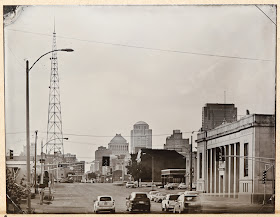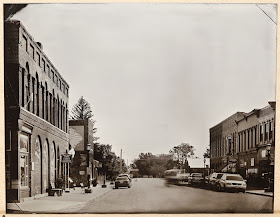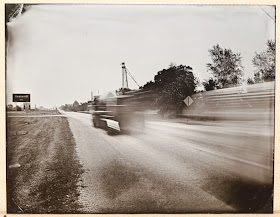A short while ago I was asked to visit my old Alma Mater San Jose State University to be featured in their Humanities and Arts Showcase event. I was more than happy to do so as it provided me yet another opportunity for a short road trip before the end of the year along with being able to support the school I owe so much of my development as an artist to. To make this trip more productive (and to try to recoup the funds that had to be spent on diesel) I also contacted SJ Institute of Contemporary Arts to see if they would like to host a tintype portrait session as part of the first Friday art walk in San Jose. They were happy to do this and so I set off toward SF Bay Area.
On the drive north I stopped for a night at the house of Lori Pond in Pasadena. Lori found me through a mutual friend and was interested in setting up the darkroom and acquiring the gear needed to start practicing wet plate photography. I was thrilled to have an opportunity to be involved in a birth of another darkroom. I spent a couple of weeks prior to the trip gathering together all the gear and when I showed up on Lori's doorsteps I was bearing all ingredients needed for her to get started. I even brought her a beautiful darkroom sink that's been in my darkroom for a while now - I'm happy that soon it will contribute to image-making once again!
The drive north was uneventful - I took my time and gave this 400mi drive a whole day rather than trying to do it all at once. This was a great decision and when I got to SJSU late at night I finally could say that a long drive didn't cost me too much pain and suffering. Luckily the parking behind the art building was reserved and so I pulled in there and went to sleep in peace.
On Friday morning I wanted to make a few plates before students and prospective students were to start coming through the bus for tours. I can't say that SJSU has the most picturesque campuses I have ever seen, but it was MY campus and so I felt strongly that I should document whatever was around me through my years as a student there. As I mentioned above, I was parked in the back of the art building and so that was where I made the following images.
At about 11am the flow of students began as a steady stream and I had quite a lot of visitors all through the afternoon. It was great to see some of my old professors too! What a marvelous time it was when I was in school - spending nights upon night in the darkroom and taking all sorts of art classes in various disciplines. If I could do it all again I would do the exact same thing with no drop of regret (well, maybe I would learn to draw before taking lithography...).
My next engagement was not until next Friday, so I was left exploring Bay Area with Gilli-the-bus as my companion. I decided to stay for a few nights with one of my ex-classmates James Pollard, who lives not to far from campus. James is a painter and came into the fine art program 'straight off the streets', meaning he never had any kind of prior experience in the area, but was compelled to be a painter via a personal revelation. Now he is pursuing it with vigor and I hope he will soon have a website where we all can see his work. For now I present to you this tintype of James in his back yard. We chose to have him wear his graduation gown and a helmet and armor that he made for one of his class projects. I think it's rather symbolic, but I will leave it to you my dear reader to read into the symbolism for yourself.
It seems like darkrooms are popping up now at a pretty incredible rate
(or maybe it's just me concentrating on this, so that's all I see). An
online friend of mine Chris Blevins-Morrison whom I met last time I was
in Bay Area happened to have gotten an offer of picking up an entire
darkroom set-up for free and was eager to do that. Unfortunately the
equipment was about 250 miles away and she was not looking forward to
driving that much by herself and the prospect of lugging some of the
heavier pieces once she got there. I volunteered to come along and we
had a great time on the road to and back from Sequoia National Forest.
Chis works as a nurse, but is getting very involved with photography and
I applaud her especially for working with film and alternative
processes. She is working on a project about women artists and is still
finalizing what process will be used in printing those images. The
cool thing is that they will NOT be digital. She shoots with a
Rolleiflex (another kudos from me) and now got herself a 5x7 view camera
as well.
We chose to take highway 178 from Bakersfield to get to our
destination. This two lane road winds rapidly at the bottom of a steep
canyon. On one hand I wished I had the bus with me so I could make some
tintypes, but on the other hand I was glad to be driving a much smaller
vehicle. The canyon finally opens up onto Lake Isabella and here are a
couple of Fuji Intax images of that.
The equipment we were to pick up at one point belonged to a
photographer who lived in Wofford Heights. Recently he has developed
dementia and is now living in a care facility, so his double-wide
trailer home complete with a darkroom is now being cleaned up for an
upcoming sale. Judging by the equipment he knew what he was doing and I
wish I could see some of his images. There were lots of Linhoff 4x5
holders, Zone VI gadgets and the Omega 2D enlarger had a really nice
cold light head on it. There was even a really cool old Beseler
enlarger table the likes of which I have never seen - that thing took us
a little while to disassemble, but it was all worth it. Chris was
really happy to get all that she needed for a darkroom (and more) in one
place and I could see that she really appreciated the history of this
equipment as well. I hope it serves her for a long time. We drove home
to Bay Area tired, but happy. The road back was once again filled with
photo-talk and I couldn't have been happier. We must have gotten back around 4am....
I must say that two of my favorite things about that area are the redwood-covered hills and the coastline. With that in mind I decided to dive into Big Basin State Park to make a couple of plates. The drive west on a tiny and extremely windy highway 9 could be a challenge even for a car, but in a 35ft bus it was a serious feat. Nonetheless I made it almost to the official park entrance when I saw a place to pull over that was surrounded by scenery that I could see myself photographing. Redwoods are some of the biggest trees on the planet (in fact the tallest tree in the world is indeed a redwood), so I decided to step up from my regular 4x5 and make some 8x10 images instead. If you have ever been in a forest of tall pine you probably remember how extremely spotty the light is and how contrasty the entire scene is, so it was a bit difficult to shoot with already high-contrast wet plate emulsion... Here is Gilli surrounded by the forest and the two 8x10 plates that resulted from the shoot.
The next day I thought I should go explore the coastline above Half Moon Bay on the way to my friend Kirill Klylov's place in Pacifica. I chose the lesser of all hills that lead across the hills to the coast - highway 92. Still, the going was very slow and I had to pull off at almost every possible place to let by the traffic that quickly stacked behind me. At one of such pull-offs I was surrounded by a very cool looking forest and decided to stop for a while and shoot. I really love the way these images turned out. Oh yeah, exposure times were up to 1min 20sec at f8! It was VERY deep shade there....
I was closer than I thought to the coast and so had time to make quite a few tintypes before the sun went down. I won't bore you with all of them, but here is an image of Gilli on the beautiful California coast and a couple of my favorite plates taken by the town of Pacifica.
On Thursday I headed back to San Jose area and once again stayed the night at James Pollard's place in Campbell. The next day I had a tintype shoot scheduled at SJICA and this was to be my first real shoot using strobe lighting, so I wanted to practice one more time to nail down the exposure and all that. We waited till pretty late at night to start the shoot (which might explain the expression on James' face), but I pretty much nailed the shot from first plate (to be completely honest the very first plate was ruined by me forgetting to take the lens cap off, but the first plate that did receive light was the one that worked out, so I count that as a win). Here is James once again, but under artificial light:
Friday I pulled up to SJICA earlier than need be and parked Gilli right in front.
Because it was still light out and I thought that people won't start showing up till much later I decided to walk up 1st street to see how San Jose has changed in the past couple of years. Well, it hasn't changed too much, but imagine my surprise when I ran into Dora Lee - an old classmate of mine from back in SJSU days. We had a good time catching up and she later stopped by the shoot as well.
I got back to the bus just before 5 thinking that I'll have plenty of time to set up, test everything, wait for the light to go down and then start shooting. Well, that was not to be so - there was already a couple with two kids waiting by the bus to have their tintype made! I scrambled to set up the background (which, by the way, I have sown magnets into so now it's really quick to attach it directly to the bus and it will NEVER blow over!), the camera and chemistry. While doing all that I gave my first customers a brief overview of things pertaining to collodion and showed them my samples. After I set up the chemistry and camera it dawned on me to ask what size image they would want. I was offering 3.5x4.5, 4x6 and 8x10. To my delight they decided to go with the 8x10. That meant a quick change in the darkroom setup, but they were very patient and looked over my movements with interest. Also, by the time we were set to go the sun was still out and though the background was in the shade I still think it would have given us a ghost image if I was to do a natural light in combination with flash, so I decided to go all natural with exposure time being about 12 seconds. That is a LONG time for anyone, but especially a 4 year old boy to sit still (I think that's how old the youngest one was.... I'm not good at estimating these things). We had to do two plates in the end - in the first one both he and his sister were pretty fidgety and came out as classic collodion blurs, while during the second exposure the girl sat vary still and the boy only moved for a second, so came out much better than the first time. Here is that 8x10 after varnishing - I think it came out rather well considering the circumstances.
Next I did a couple of portraits of some of the staff of ICA and this time there was no problems with movement at all because the flashes were in use. Here they are while still in the wash.
After the shoot I went out for a beer with some of my old San Jose friends and then started to drive back south.
It was another uneventful drive I am now sitting in a coffee shop in Glendale and waiting for Lori Pond to get back home so we can start to work on her wet plate darkroom. Tomorrow we should install the vent and the sink and then we'll get a chance to test out all her gear and chemistry, that should be fun.
And so comes to the end my short trip up to the Bay Area. It was fun and I hope to do this again - I think CA is a great place to travel in the winter - it's big enough and most of it doesn't get cold enough to be prohibitive to Gilli-the-Gillig.
Anton Orlov






































































































































